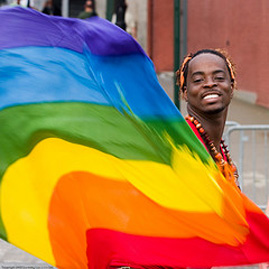New York Historical Society Present AIDS in New York: The First Five Years
early history of the AIDS epidemic in New York City—from the first
rumors in 1981 of a “gay plague” through the ensuing period of intense
activism, clinical research, and political struggle—will be the subject
of a major new exhibition at the New-York Historical Society, AIDS in New York: The First Five Years, on view from June 7 through September 15, 2013.
With a wealth of materials drawn from New-York Historical’s archives
as well as the archives of the New York Public Library, New York
University, and the National Archive of LGBT History, the exhibition
will use artifacts including clinicians’ notes, journal entries,
diaries, letters, audio and video clips, posters, photographs,
pamphlets, and newspapers to revisit the impact of the epidemic on
personal lives and public culture in New York City and the nation.
“For those who lost partners, children, siblings, parents, and
friends, the memory of the fear and mystery that pervaded New York at
the beginning of the AIDS epidemic remains vivid,” said curator Jean S.
Ashton. “For many people today, though, these years are now a
little-understood and nearly forgotten historical period. Yet the
trajectory of HIV/AIDS changed paradigms in medicine, society, politics,
and culture in ways that are still being felt, and the disease remains
with us, affecting some 100,000 New Yorkers and more than one million
Americans today. This exhibition explores a history that we continue to
live.”
The exhibition will begin by recalling life in New York in the
pre-AIDS period, especially the exhilarating sense of artistic and
sexual freedom that followed the 1969 Stonewall Riots, which establishes
the social and political context for the earliest reports from medical
professionals of the physical decline and deaths of previously healthy
young people afflicted with diseases usually found only in the aged.
This section will feature the personal stories of the first AIDS
patients and their caretakers and give voice to the doctors who cared
for these patients. Because more than 80 percent of those infected were
homosexual males, rumors of a “gay plague” circulated. Anchor objects in
this area of the exhibition include a copy of the national medical
bulletin Mortality and Morbidity Weekly Report that first mentioned the disease, the July 3, 1981 New York Times article that was the first national media story, and a variety of reports published in the gay press.
As cases of this new epidemic were discovered outside the gay
community, in heroin drug injectors, babies, and people who had had
blood transfusions, the challenges posed to researchers and those caring
for the sick intensified. Racing at once to discover the possible
cause or causes of the disease in order to contain its spread and to
alleviate the social and political impact of the growing rate of
infection and death, scientists, social workers, and members of the
affected populations and their friends struggled together to raise funds
and influence research priorities. By the middle of 1983, responses
from the community, including increasingly militant victims of the
disease, began to take shape to demand support for social services and
raise new monies for research. In New York, even more than elsewhere,
AIDS was a political issue, pitting the Mayor against a vocal
constituency that demanded action.
The second section of the exhibition will explore the impediments
that prevented any quick solution to the growing problem. An epidemic
of fear swept the city, fueled by rumors and stoked by exploitative news
coverage, as funeral directors refused to embalm the bodies of AIDS
victims, parents protested the admission of AIDS victims to public
schools, and some hospitals refused to admit people suffering from the
disease.
The third and final section traces both the progress of
research on the causes of the epidemic, the development of AIDS
philanthropy, and the growth of the anger and mistrust that would
explode after the founding of ACT-UP in 1986. On display in this section
will be slides and documents from the 1984 Park City Utah conference
where Jean-Claude Chermann, a virologist from the Nobel-Prize winning
team at the Pasteur Institute in Paris electrified the room by
presenting evidence announcing the discovery of the retrovirus which
would ultimately be identified as Human Immunodeficiency Virus (HIV),
and would make possible the development of the first commercial test kit
for the presence of the virus (also on display).
and other philanthropic organizations, and the strengthened role of the
Gay Men’s Health Crisis, also documented here, would enable the
successful public outreach of the following decades. The gallery will
focus on the landmark New York production of Larry Kramer’s powerful
call to action, The Normal Heart, and will end with the highly publicized illness and death of movie star Rock Hudson in October, 1985.
Also included in the exhibition is a panel from the AIDS quilt
memorializing Roger Gail Lyon, an early victim of the epidemic whose
plea that he not die of “red tape” articulated the frustration of the
AIDs community.
The years documented in AIDS in New York: The First Five Years
preceded the founding of ACT-UP, whose commitment to activism and
dramatic achievements will be illustrated in an exhibition at the New
York Public Library entitled
Generous support for AIDS in New York: The First Five Years is provided, in part, by Ford Foundation and by The New York Community Trust.
















Leave a Reply